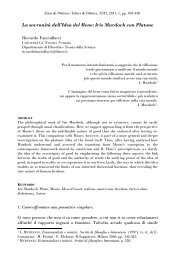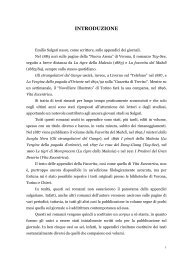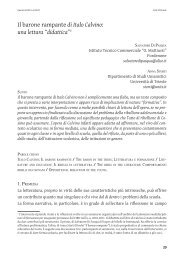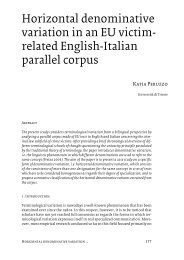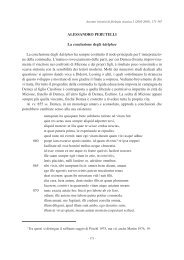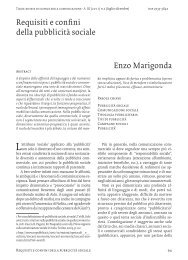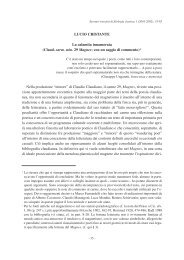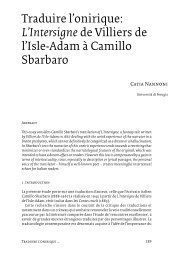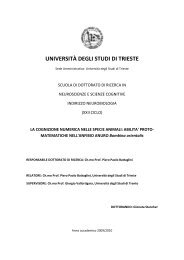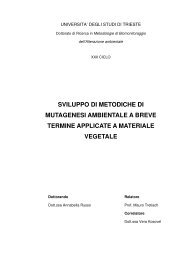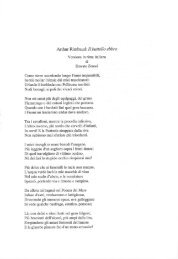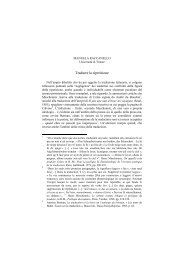Melchiorre Cesarotti e le trasformazioni del paesaggio ... - OpenstarTs
Melchiorre Cesarotti e le trasformazioni del paesaggio ... - OpenstarTs
Melchiorre Cesarotti e le trasformazioni del paesaggio ... - OpenstarTs
Create successful ePaper yourself
Turn your PDF publications into a flip-book with our unique Google optimized e-Paper software.
coloso». In fact, the appeal to naturalness of much late 18 th and early 19 th century<br />
landscape theory did not sit comfortably with Italian commentators.<br />
If the Italian gardenists took anything from general English landscape theory<br />
it was above all the need for variety – a long-established aesthetic criterion not<br />
specifically English (though much touted by English landscape writers in their<br />
promotion of natural effects); now it could be re-interpreted afresh – Bettini’s<br />
fantastic design for a multi-faceted country seat being just one manifestation of<br />
this appeal to a various formula. Another was what Giannantonio Selva produced<br />
for the Venetian Public Gardens, albeit after much debate and vacillation. 28<br />
Two aspects of this civic project that mattered intensely in Venice were the<br />
choice of an appropriate landscape vocabulary for modern public gardens, and<br />
the se<strong>le</strong>ction of e<strong>le</strong>ments suited to the site, its locality, its genius loci. The appeal<br />
to modernity clashed with notions of specific locality, for whi<strong>le</strong> Venice had many<br />
private gardens, none had (at <strong>le</strong>ast for centuries) ever been public. New public<br />
grounds authorized by Napo<strong>le</strong>on needed both piazza d’armi and open areas for<br />
social activity, like a grandiosa passeggiata, what Zanotto in 1847 cal<strong>le</strong>d «giardin<br />
di passeggio, che domanda larghi e diriti viali, e proscrive cio tutto che tien <strong>del</strong><br />
diffici<strong>le</strong> e complicate». But modern gardens by definition also had to be ‘natural’<br />
and picturesque, which meant utilizing the viewsheds over the lagoon, exploiting<br />
the high point of the Motta at the end of the site and ensuring that there<br />
were some meandering, private areas for the solitary promeneur. Selva seems<br />
to have compromised between these various claims upon his project – with a<br />
largely regular entry avenue, rectang<strong>le</strong>s of grass and grove, all juxtaposed at the<br />
end of the site to a determinedly picturesque shrubbery with meandering paths,<br />
what Selva himself cal<strong>le</strong>d «sentimental greenery» [Figure 11]. No wonder some<br />
critics complained of its French taste (notably Gaetano Pinali), and others of its<br />
unnecessarily English sty<strong>le</strong>: Pietro Selvatico wrote of its «gretti e monotoni viali<br />
… monticelli sgarbati con ma<strong>le</strong> distribuite macchie di verde».<br />
The mixed agenda was perp<strong>le</strong>xing for designers and visitors alike. These gardens<br />
had to honour their new French masters (so be somehow ‘French’), to incorporate<br />
a who<strong>le</strong> cluster of local programmes (guard houses, shops, cafes, trattorie,<br />
bathing stations, terraces, riding-stab<strong>le</strong>s – only some of which were ever realized);<br />
they had also to honour the unique urban situation, difficult because the old topography<br />
of private and monastic gardens was entirely swept away in order to establish<br />
the public gardens; even the old windmills on the highpoint of the Motta were<br />
demolished, even though they might, if retained (as Selva for a whi<strong>le</strong> considered),<br />
have performed the ro<strong>le</strong> of some ‘ancient’ fabriques. 29 The eventual installation in<br />
1822 of the archway from Sanmiche<strong>le</strong>’s former church was a meagre gesture towards<br />
historical locality [Figure 12]. The who<strong>le</strong> site, argued Antonio Diedo, needed<br />
28 I have discussed this project at <strong>le</strong>ngth in the seventh chapter of my book, The Venetian City<br />
Garden. Place, Typology and Perception, Basel and Berlin, 2009.<br />
29 On the ro<strong>le</strong> of fabriques or follies in designed landscapes, see my essay, Folly in the Garden,<br />
«The Hopkins Review», new series, I/2 (2008), pp.227-261.<br />
16



